A Critical Analysis of the Piaxtla Project: Health, Land, and Equity
VerifiedAdded on 2022/12/23
|12
|3369
|23
Report
AI Summary
This report offers a critical analysis of the Piaxtla Project, a rural primary healthcare program in Western Mexico, run by local villagers. The project, initiated in 1965, aimed to address the 'diseases of poverty' prevalent in the region, focusing on health inequities stemming from unequal distribution of land, wealth, and power. The analysis examines the project through the lens of participatory planning, exploring its needs assessment, stakeholder involvement, and strategies to address inequity. The report details the evolution of the project from providing therapeutic care to implementing preventive measures like vaccinations and sanitation, ultimately improving overall well-being. It also highlights the community's efforts to combat land exploitation, promote economic empowerment, and advocate for social justice. The report discusses the project's alignment with participatory planning principles, including community participation, shared decision-making, and the empowerment of rural communities to address health and social challenges. The Piaxtla project is a significant case study in how participatory planning approaches can improve health outcomes and promote social justice in underserved communities.
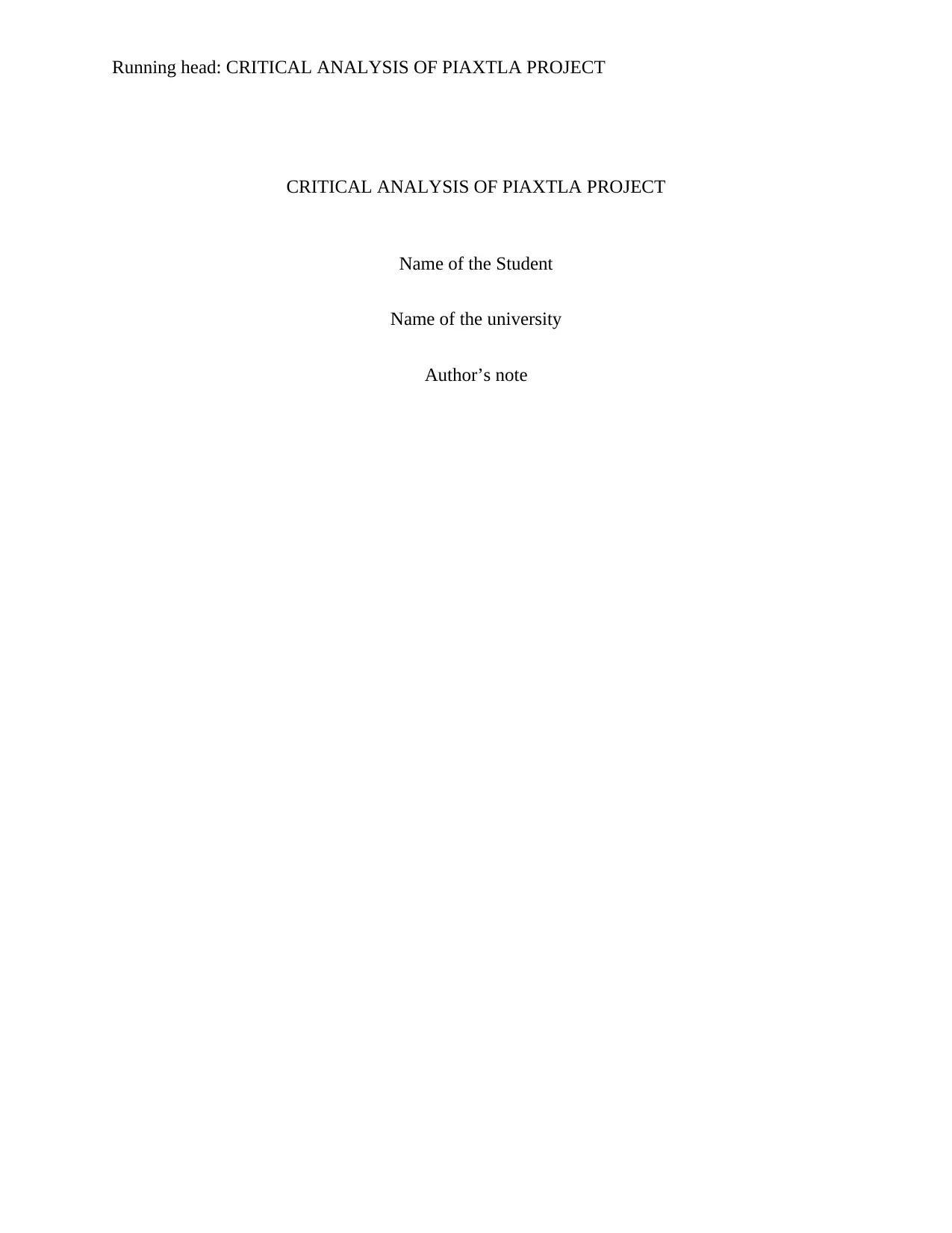
Running head: CRITICAL ANALYSIS OF PIAXTLA PROJECT
CRITICAL ANALYSIS OF PIAXTLA PROJECT
Name of the Student
Name of the university
Author’s note
CRITICAL ANALYSIS OF PIAXTLA PROJECT
Name of the Student
Name of the university
Author’s note
Paraphrase This Document
Need a fresh take? Get an instant paraphrase of this document with our AI Paraphraser
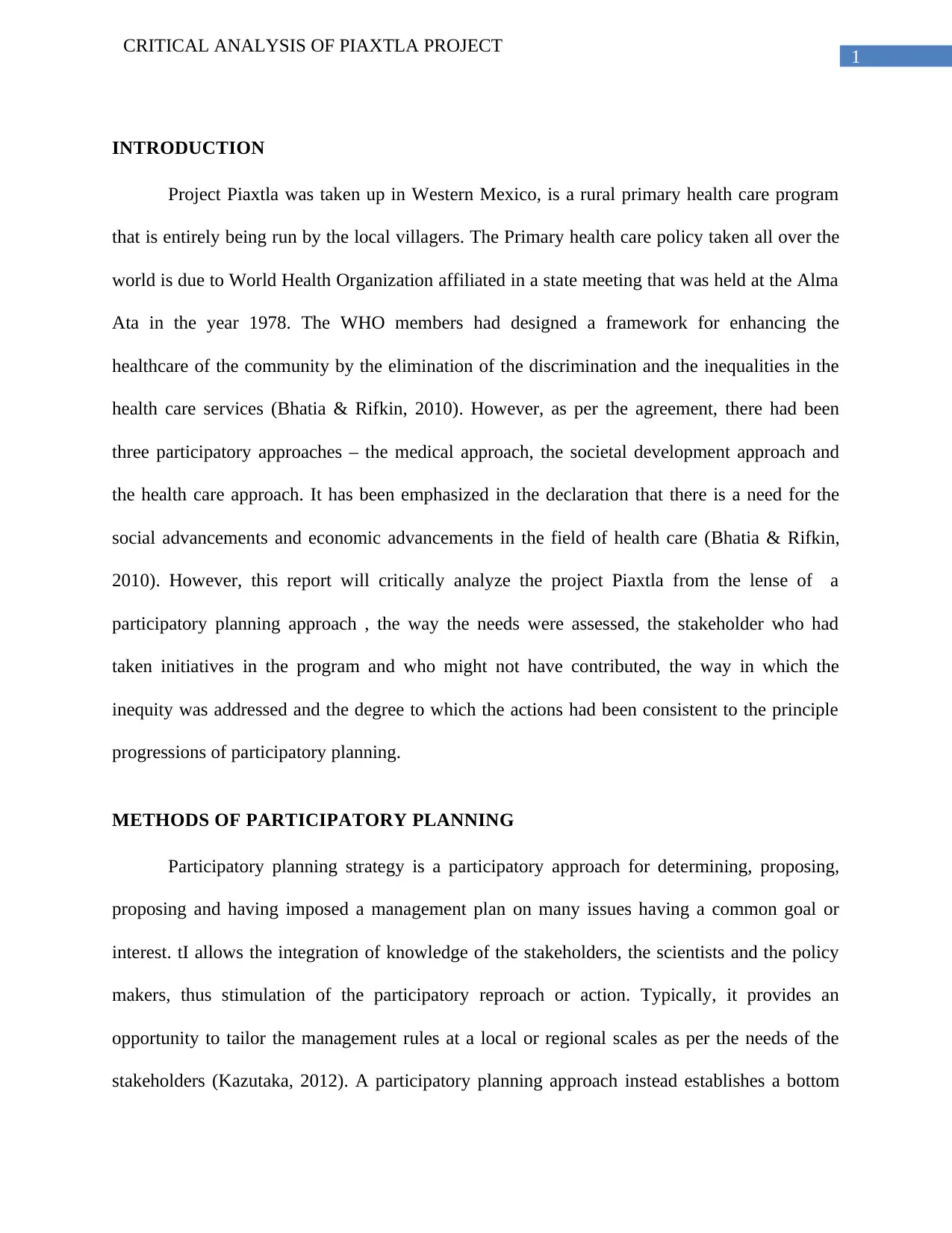
1
CRITICAL ANALYSIS OF PIAXTLA PROJECT
INTRODUCTION
Project Piaxtla was taken up in Western Mexico, is a rural primary health care program
that is entirely being run by the local villagers. The Primary health care policy taken all over the
world is due to World Health Organization affiliated in a state meeting that was held at the Alma
Ata in the year 1978. The WHO members had designed a framework for enhancing the
healthcare of the community by the elimination of the discrimination and the inequalities in the
health care services (Bhatia & Rifkin, 2010). However, as per the agreement, there had been
three participatory approaches – the medical approach, the societal development approach and
the health care approach. It has been emphasized in the declaration that there is a need for the
social advancements and economic advancements in the field of health care (Bhatia & Rifkin,
2010). However, this report will critically analyze the project Piaxtla from the lense of a
participatory planning approach , the way the needs were assessed, the stakeholder who had
taken initiatives in the program and who might not have contributed, the way in which the
inequity was addressed and the degree to which the actions had been consistent to the principle
progressions of participatory planning.
METHODS OF PARTICIPATORY PLANNING
Participatory planning strategy is a participatory approach for determining, proposing,
proposing and having imposed a management plan on many issues having a common goal or
interest. tI allows the integration of knowledge of the stakeholders, the scientists and the policy
makers, thus stimulation of the participatory reproach or action. Typically, it provides an
opportunity to tailor the management rules at a local or regional scales as per the needs of the
stakeholders (Kazutaka, 2012). A participatory planning approach instead establishes a bottom
CRITICAL ANALYSIS OF PIAXTLA PROJECT
INTRODUCTION
Project Piaxtla was taken up in Western Mexico, is a rural primary health care program
that is entirely being run by the local villagers. The Primary health care policy taken all over the
world is due to World Health Organization affiliated in a state meeting that was held at the Alma
Ata in the year 1978. The WHO members had designed a framework for enhancing the
healthcare of the community by the elimination of the discrimination and the inequalities in the
health care services (Bhatia & Rifkin, 2010). However, as per the agreement, there had been
three participatory approaches – the medical approach, the societal development approach and
the health care approach. It has been emphasized in the declaration that there is a need for the
social advancements and economic advancements in the field of health care (Bhatia & Rifkin,
2010). However, this report will critically analyze the project Piaxtla from the lense of a
participatory planning approach , the way the needs were assessed, the stakeholder who had
taken initiatives in the program and who might not have contributed, the way in which the
inequity was addressed and the degree to which the actions had been consistent to the principle
progressions of participatory planning.
METHODS OF PARTICIPATORY PLANNING
Participatory planning strategy is a participatory approach for determining, proposing,
proposing and having imposed a management plan on many issues having a common goal or
interest. tI allows the integration of knowledge of the stakeholders, the scientists and the policy
makers, thus stimulation of the participatory reproach or action. Typically, it provides an
opportunity to tailor the management rules at a local or regional scales as per the needs of the
stakeholders (Kazutaka, 2012). A participatory planning approach instead establishes a bottom
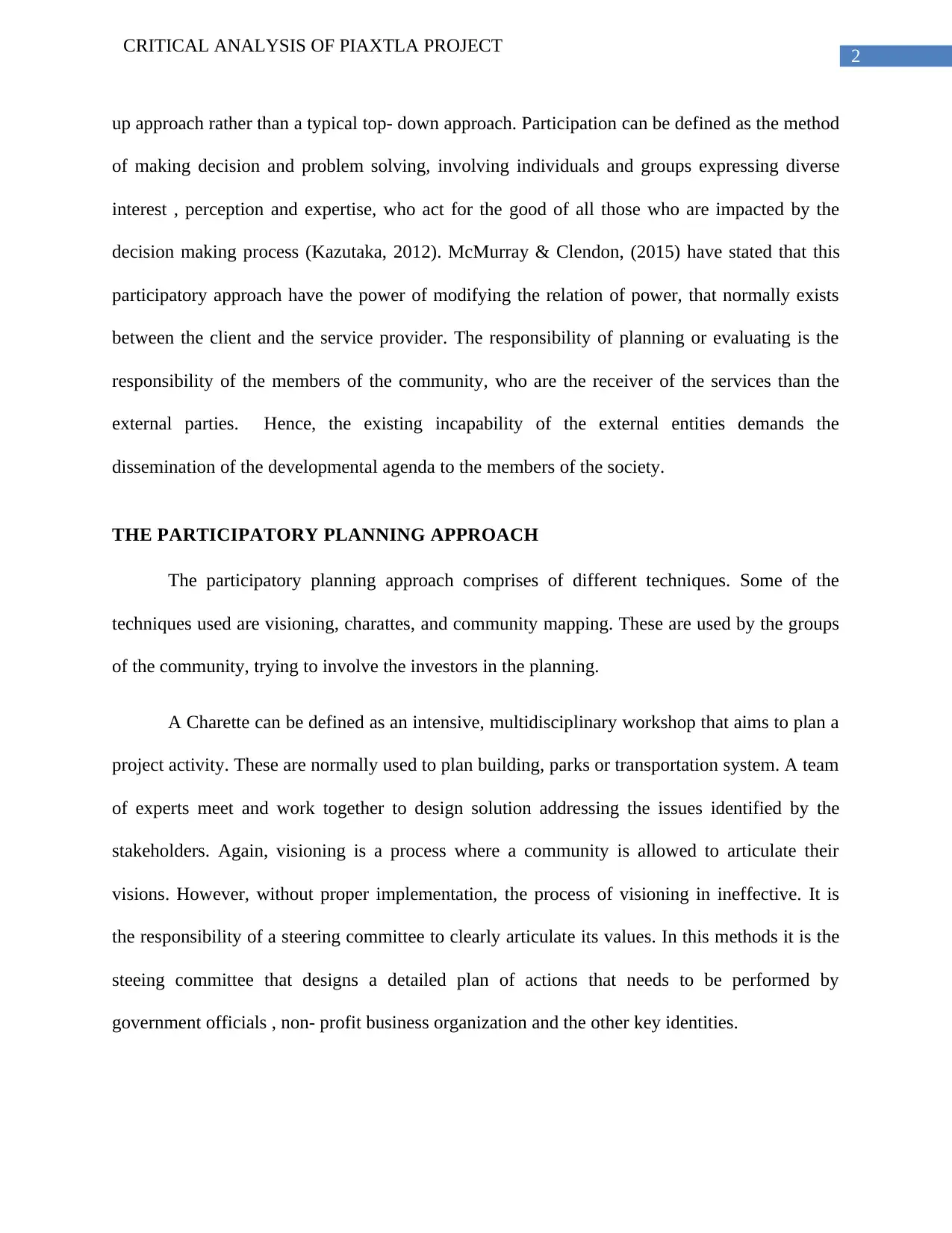
2
CRITICAL ANALYSIS OF PIAXTLA PROJECT
up approach rather than a typical top- down approach. Participation can be defined as the method
of making decision and problem solving, involving individuals and groups expressing diverse
interest , perception and expertise, who act for the good of all those who are impacted by the
decision making process (Kazutaka, 2012). McMurray & Clendon, (2015) have stated that this
participatory approach have the power of modifying the relation of power, that normally exists
between the client and the service provider. The responsibility of planning or evaluating is the
responsibility of the members of the community, who are the receiver of the services than the
external parties. Hence, the existing incapability of the external entities demands the
dissemination of the developmental agenda to the members of the society.
THE PARTICIPATORY PLANNING APPROACH
The participatory planning approach comprises of different techniques. Some of the
techniques used are visioning, charattes, and community mapping. These are used by the groups
of the community, trying to involve the investors in the planning.
A Charette can be defined as an intensive, multidisciplinary workshop that aims to plan a
project activity. These are normally used to plan building, parks or transportation system. A team
of experts meet and work together to design solution addressing the issues identified by the
stakeholders. Again, visioning is a process where a community is allowed to articulate their
visions. However, without proper implementation, the process of visioning in ineffective. It is
the responsibility of a steering committee to clearly articulate its values. In this methods it is the
steeing committee that designs a detailed plan of actions that needs to be performed by
government officials , non- profit business organization and the other key identities.
CRITICAL ANALYSIS OF PIAXTLA PROJECT
up approach rather than a typical top- down approach. Participation can be defined as the method
of making decision and problem solving, involving individuals and groups expressing diverse
interest , perception and expertise, who act for the good of all those who are impacted by the
decision making process (Kazutaka, 2012). McMurray & Clendon, (2015) have stated that this
participatory approach have the power of modifying the relation of power, that normally exists
between the client and the service provider. The responsibility of planning or evaluating is the
responsibility of the members of the community, who are the receiver of the services than the
external parties. Hence, the existing incapability of the external entities demands the
dissemination of the developmental agenda to the members of the society.
THE PARTICIPATORY PLANNING APPROACH
The participatory planning approach comprises of different techniques. Some of the
techniques used are visioning, charattes, and community mapping. These are used by the groups
of the community, trying to involve the investors in the planning.
A Charette can be defined as an intensive, multidisciplinary workshop that aims to plan a
project activity. These are normally used to plan building, parks or transportation system. A team
of experts meet and work together to design solution addressing the issues identified by the
stakeholders. Again, visioning is a process where a community is allowed to articulate their
visions. However, without proper implementation, the process of visioning in ineffective. It is
the responsibility of a steering committee to clearly articulate its values. In this methods it is the
steeing committee that designs a detailed plan of actions that needs to be performed by
government officials , non- profit business organization and the other key identities.
⊘ This is a preview!⊘
Do you want full access?
Subscribe today to unlock all pages.

Trusted by 1+ million students worldwide
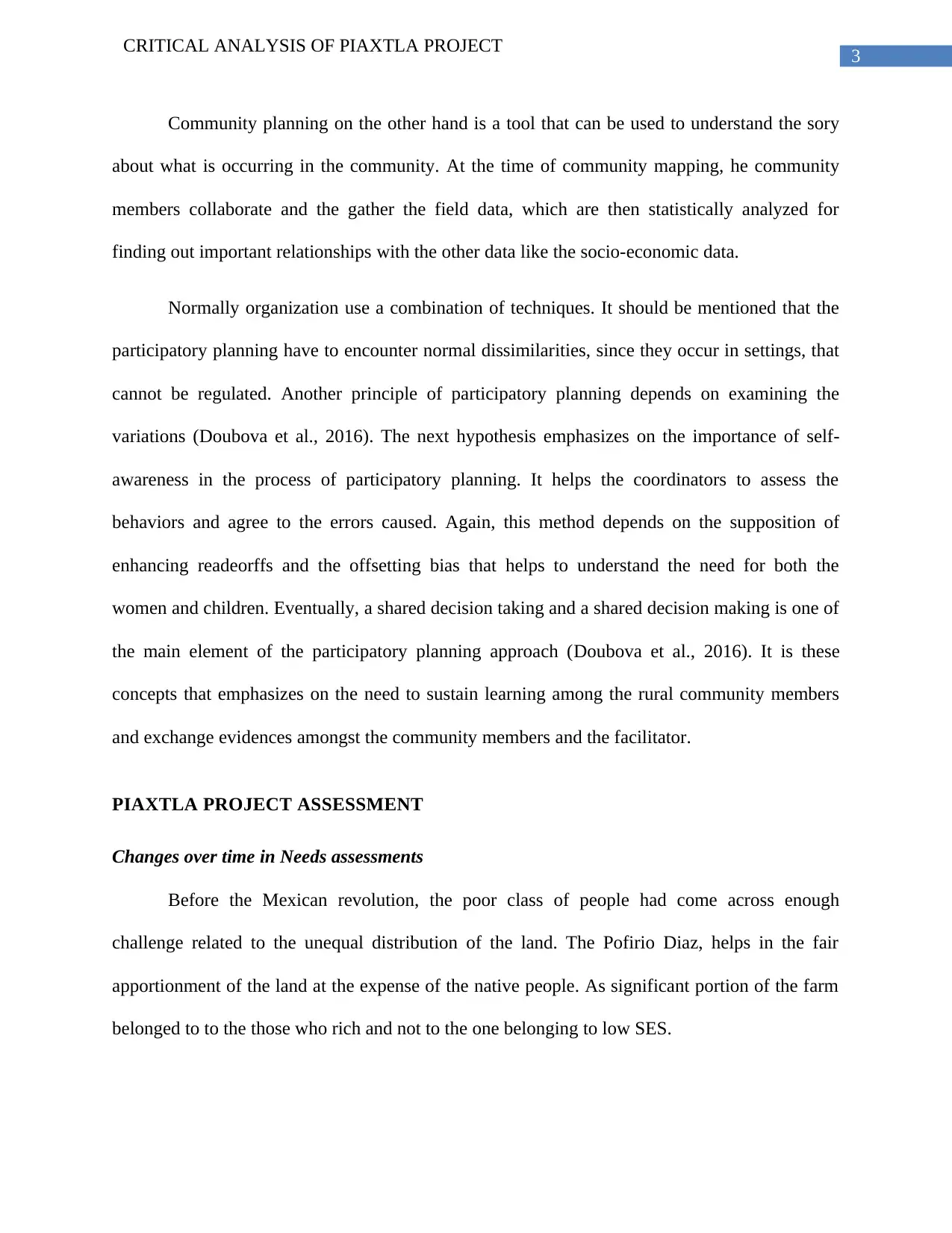
3
CRITICAL ANALYSIS OF PIAXTLA PROJECT
Community planning on the other hand is a tool that can be used to understand the sory
about what is occurring in the community. At the time of community mapping, he community
members collaborate and the gather the field data, which are then statistically analyzed for
finding out important relationships with the other data like the socio-economic data.
Normally organization use a combination of techniques. It should be mentioned that the
participatory planning have to encounter normal dissimilarities, since they occur in settings, that
cannot be regulated. Another principle of participatory planning depends on examining the
variations (Doubova et al., 2016). The next hypothesis emphasizes on the importance of self-
awareness in the process of participatory planning. It helps the coordinators to assess the
behaviors and agree to the errors caused. Again, this method depends on the supposition of
enhancing readeorffs and the offsetting bias that helps to understand the need for both the
women and children. Eventually, a shared decision taking and a shared decision making is one of
the main element of the participatory planning approach (Doubova et al., 2016). It is these
concepts that emphasizes on the need to sustain learning among the rural community members
and exchange evidences amongst the community members and the facilitator.
PIAXTLA PROJECT ASSESSMENT
Changes over time in Needs assessments
Before the Mexican revolution, the poor class of people had come across enough
challenge related to the unequal distribution of the land. The Pofirio Diaz, helps in the fair
apportionment of the land at the expense of the native people. As significant portion of the farm
belonged to to the those who rich and not to the one belonging to low SES.
CRITICAL ANALYSIS OF PIAXTLA PROJECT
Community planning on the other hand is a tool that can be used to understand the sory
about what is occurring in the community. At the time of community mapping, he community
members collaborate and the gather the field data, which are then statistically analyzed for
finding out important relationships with the other data like the socio-economic data.
Normally organization use a combination of techniques. It should be mentioned that the
participatory planning have to encounter normal dissimilarities, since they occur in settings, that
cannot be regulated. Another principle of participatory planning depends on examining the
variations (Doubova et al., 2016). The next hypothesis emphasizes on the importance of self-
awareness in the process of participatory planning. It helps the coordinators to assess the
behaviors and agree to the errors caused. Again, this method depends on the supposition of
enhancing readeorffs and the offsetting bias that helps to understand the need for both the
women and children. Eventually, a shared decision taking and a shared decision making is one of
the main element of the participatory planning approach (Doubova et al., 2016). It is these
concepts that emphasizes on the need to sustain learning among the rural community members
and exchange evidences amongst the community members and the facilitator.
PIAXTLA PROJECT ASSESSMENT
Changes over time in Needs assessments
Before the Mexican revolution, the poor class of people had come across enough
challenge related to the unequal distribution of the land. The Pofirio Diaz, helps in the fair
apportionment of the land at the expense of the native people. As significant portion of the farm
belonged to to the those who rich and not to the one belonging to low SES.
Paraphrase This Document
Need a fresh take? Get an instant paraphrase of this document with our AI Paraphraser
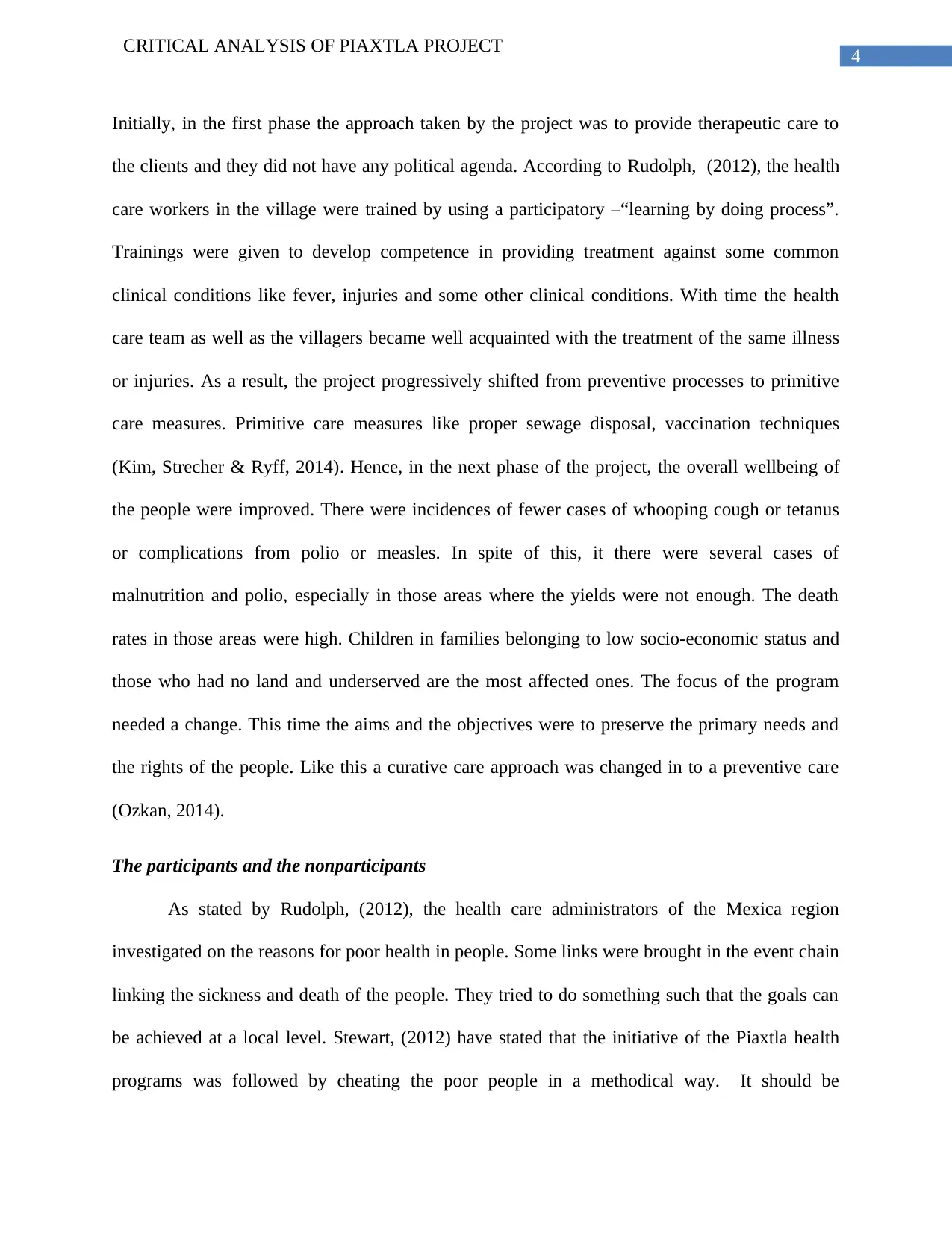
4
CRITICAL ANALYSIS OF PIAXTLA PROJECT
Initially, in the first phase the approach taken by the project was to provide therapeutic care to
the clients and they did not have any political agenda. According to Rudolph, (2012), the health
care workers in the village were trained by using a participatory –“learning by doing process”.
Trainings were given to develop competence in providing treatment against some common
clinical conditions like fever, injuries and some other clinical conditions. With time the health
care team as well as the villagers became well acquainted with the treatment of the same illness
or injuries. As a result, the project progressively shifted from preventive processes to primitive
care measures. Primitive care measures like proper sewage disposal, vaccination techniques
(Kim, Strecher & Ryff, 2014). Hence, in the next phase of the project, the overall wellbeing of
the people were improved. There were incidences of fewer cases of whooping cough or tetanus
or complications from polio or measles. In spite of this, it there were several cases of
malnutrition and polio, especially in those areas where the yields were not enough. The death
rates in those areas were high. Children in families belonging to low socio-economic status and
those who had no land and underserved are the most affected ones. The focus of the program
needed a change. This time the aims and the objectives were to preserve the primary needs and
the rights of the people. Like this a curative care approach was changed in to a preventive care
(Ozkan, 2014).
The participants and the nonparticipants
As stated by Rudolph, (2012), the health care administrators of the Mexica region
investigated on the reasons for poor health in people. Some links were brought in the event chain
linking the sickness and death of the people. They tried to do something such that the goals can
be achieved at a local level. Stewart, (2012) have stated that the initiative of the Piaxtla health
programs was followed by cheating the poor people in a methodical way. It should be
CRITICAL ANALYSIS OF PIAXTLA PROJECT
Initially, in the first phase the approach taken by the project was to provide therapeutic care to
the clients and they did not have any political agenda. According to Rudolph, (2012), the health
care workers in the village were trained by using a participatory –“learning by doing process”.
Trainings were given to develop competence in providing treatment against some common
clinical conditions like fever, injuries and some other clinical conditions. With time the health
care team as well as the villagers became well acquainted with the treatment of the same illness
or injuries. As a result, the project progressively shifted from preventive processes to primitive
care measures. Primitive care measures like proper sewage disposal, vaccination techniques
(Kim, Strecher & Ryff, 2014). Hence, in the next phase of the project, the overall wellbeing of
the people were improved. There were incidences of fewer cases of whooping cough or tetanus
or complications from polio or measles. In spite of this, it there were several cases of
malnutrition and polio, especially in those areas where the yields were not enough. The death
rates in those areas were high. Children in families belonging to low socio-economic status and
those who had no land and underserved are the most affected ones. The focus of the program
needed a change. This time the aims and the objectives were to preserve the primary needs and
the rights of the people. Like this a curative care approach was changed in to a preventive care
(Ozkan, 2014).
The participants and the nonparticipants
As stated by Rudolph, (2012), the health care administrators of the Mexica region
investigated on the reasons for poor health in people. Some links were brought in the event chain
linking the sickness and death of the people. They tried to do something such that the goals can
be achieved at a local level. Stewart, (2012) have stated that the initiative of the Piaxtla health
programs was followed by cheating the poor people in a methodical way. It should be
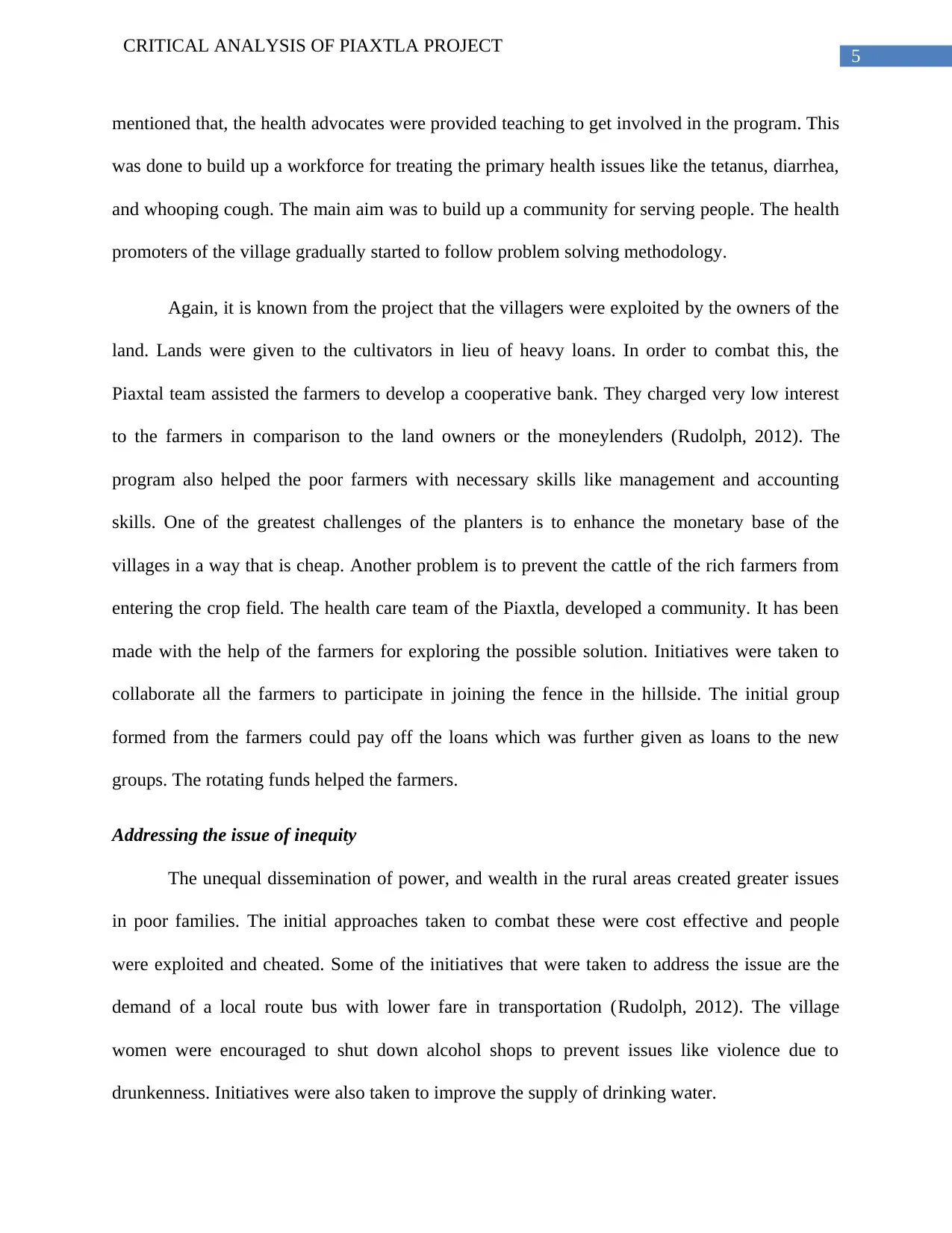
5
CRITICAL ANALYSIS OF PIAXTLA PROJECT
mentioned that, the health advocates were provided teaching to get involved in the program. This
was done to build up a workforce for treating the primary health issues like the tetanus, diarrhea,
and whooping cough. The main aim was to build up a community for serving people. The health
promoters of the village gradually started to follow problem solving methodology.
Again, it is known from the project that the villagers were exploited by the owners of the
land. Lands were given to the cultivators in lieu of heavy loans. In order to combat this, the
Piaxtal team assisted the farmers to develop a cooperative bank. They charged very low interest
to the farmers in comparison to the land owners or the moneylenders (Rudolph, 2012). The
program also helped the poor farmers with necessary skills like management and accounting
skills. One of the greatest challenges of the planters is to enhance the monetary base of the
villages in a way that is cheap. Another problem is to prevent the cattle of the rich farmers from
entering the crop field. The health care team of the Piaxtla, developed a community. It has been
made with the help of the farmers for exploring the possible solution. Initiatives were taken to
collaborate all the farmers to participate in joining the fence in the hillside. The initial group
formed from the farmers could pay off the loans which was further given as loans to the new
groups. The rotating funds helped the farmers.
Addressing the issue of inequity
The unequal dissemination of power, and wealth in the rural areas created greater issues
in poor families. The initial approaches taken to combat these were cost effective and people
were exploited and cheated. Some of the initiatives that were taken to address the issue are the
demand of a local route bus with lower fare in transportation (Rudolph, 2012). The village
women were encouraged to shut down alcohol shops to prevent issues like violence due to
drunkenness. Initiatives were also taken to improve the supply of drinking water.
CRITICAL ANALYSIS OF PIAXTLA PROJECT
mentioned that, the health advocates were provided teaching to get involved in the program. This
was done to build up a workforce for treating the primary health issues like the tetanus, diarrhea,
and whooping cough. The main aim was to build up a community for serving people. The health
promoters of the village gradually started to follow problem solving methodology.
Again, it is known from the project that the villagers were exploited by the owners of the
land. Lands were given to the cultivators in lieu of heavy loans. In order to combat this, the
Piaxtal team assisted the farmers to develop a cooperative bank. They charged very low interest
to the farmers in comparison to the land owners or the moneylenders (Rudolph, 2012). The
program also helped the poor farmers with necessary skills like management and accounting
skills. One of the greatest challenges of the planters is to enhance the monetary base of the
villages in a way that is cheap. Another problem is to prevent the cattle of the rich farmers from
entering the crop field. The health care team of the Piaxtla, developed a community. It has been
made with the help of the farmers for exploring the possible solution. Initiatives were taken to
collaborate all the farmers to participate in joining the fence in the hillside. The initial group
formed from the farmers could pay off the loans which was further given as loans to the new
groups. The rotating funds helped the farmers.
Addressing the issue of inequity
The unequal dissemination of power, and wealth in the rural areas created greater issues
in poor families. The initial approaches taken to combat these were cost effective and people
were exploited and cheated. Some of the initiatives that were taken to address the issue are the
demand of a local route bus with lower fare in transportation (Rudolph, 2012). The village
women were encouraged to shut down alcohol shops to prevent issues like violence due to
drunkenness. Initiatives were also taken to improve the supply of drinking water.
⊘ This is a preview!⊘
Do you want full access?
Subscribe today to unlock all pages.

Trusted by 1+ million students worldwide
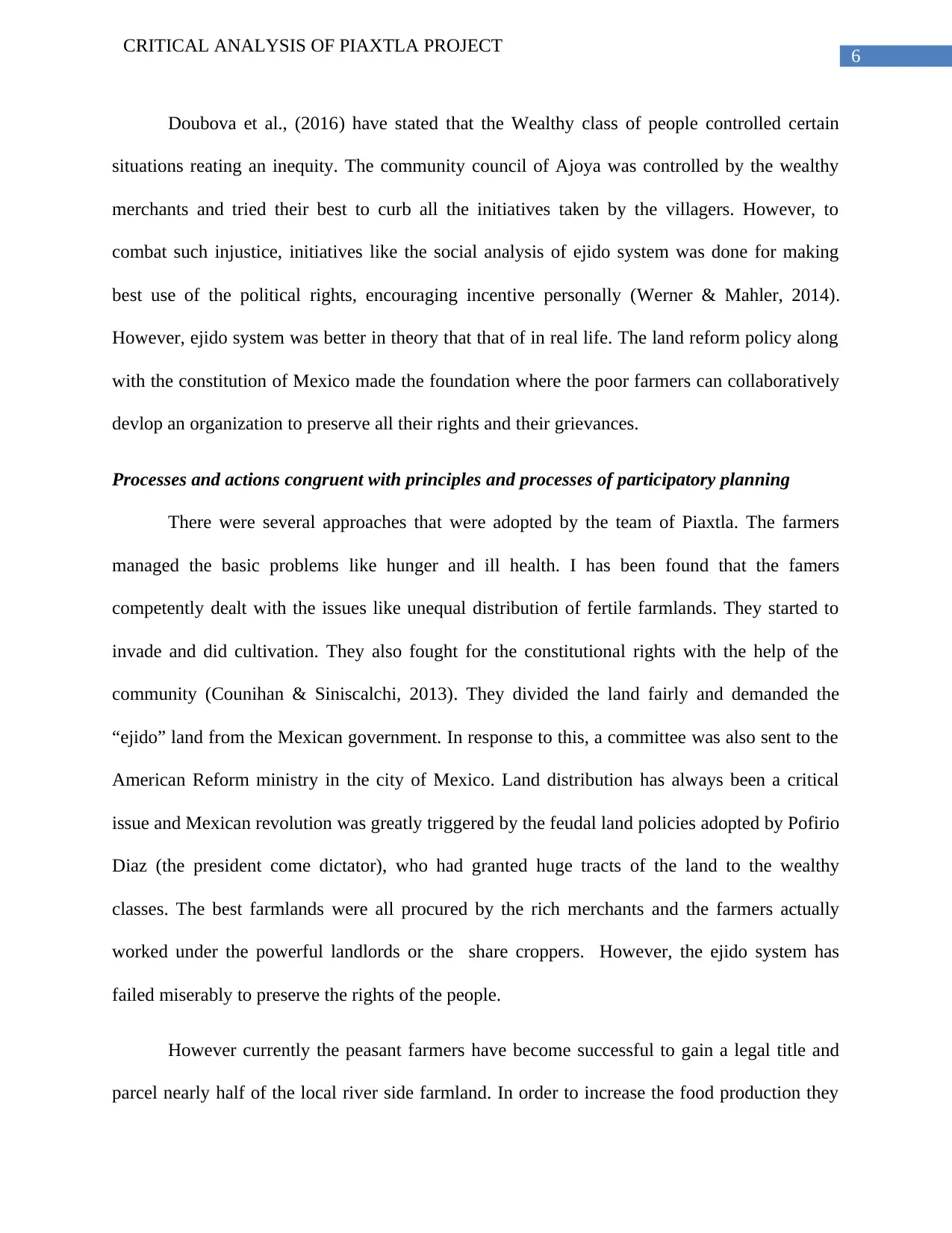
6
CRITICAL ANALYSIS OF PIAXTLA PROJECT
Doubova et al., (2016) have stated that the Wealthy class of people controlled certain
situations reating an inequity. The community council of Ajoya was controlled by the wealthy
merchants and tried their best to curb all the initiatives taken by the villagers. However, to
combat such injustice, initiatives like the social analysis of ejido system was done for making
best use of the political rights, encouraging incentive personally (Werner & Mahler, 2014).
However, ejido system was better in theory that that of in real life. The land reform policy along
with the constitution of Mexico made the foundation where the poor farmers can collaboratively
devlop an organization to preserve all their rights and their grievances.
Processes and actions congruent with principles and processes of participatory planning
There were several approaches that were adopted by the team of Piaxtla. The farmers
managed the basic problems like hunger and ill health. I has been found that the famers
competently dealt with the issues like unequal distribution of fertile farmlands. They started to
invade and did cultivation. They also fought for the constitutional rights with the help of the
community (Counihan & Siniscalchi, 2013). They divided the land fairly and demanded the
“ejido” land from the Mexican government. In response to this, a committee was also sent to the
American Reform ministry in the city of Mexico. Land distribution has always been a critical
issue and Mexican revolution was greatly triggered by the feudal land policies adopted by Pofirio
Diaz (the president come dictator), who had granted huge tracts of the land to the wealthy
classes. The best farmlands were all procured by the rich merchants and the farmers actually
worked under the powerful landlords or the share croppers. However, the ejido system has
failed miserably to preserve the rights of the people.
However currently the peasant farmers have become successful to gain a legal title and
parcel nearly half of the local river side farmland. In order to increase the food production they
CRITICAL ANALYSIS OF PIAXTLA PROJECT
Doubova et al., (2016) have stated that the Wealthy class of people controlled certain
situations reating an inequity. The community council of Ajoya was controlled by the wealthy
merchants and tried their best to curb all the initiatives taken by the villagers. However, to
combat such injustice, initiatives like the social analysis of ejido system was done for making
best use of the political rights, encouraging incentive personally (Werner & Mahler, 2014).
However, ejido system was better in theory that that of in real life. The land reform policy along
with the constitution of Mexico made the foundation where the poor farmers can collaboratively
devlop an organization to preserve all their rights and their grievances.
Processes and actions congruent with principles and processes of participatory planning
There were several approaches that were adopted by the team of Piaxtla. The farmers
managed the basic problems like hunger and ill health. I has been found that the famers
competently dealt with the issues like unequal distribution of fertile farmlands. They started to
invade and did cultivation. They also fought for the constitutional rights with the help of the
community (Counihan & Siniscalchi, 2013). They divided the land fairly and demanded the
“ejido” land from the Mexican government. In response to this, a committee was also sent to the
American Reform ministry in the city of Mexico. Land distribution has always been a critical
issue and Mexican revolution was greatly triggered by the feudal land policies adopted by Pofirio
Diaz (the president come dictator), who had granted huge tracts of the land to the wealthy
classes. The best farmlands were all procured by the rich merchants and the farmers actually
worked under the powerful landlords or the share croppers. However, the ejido system has
failed miserably to preserve the rights of the people.
However currently the peasant farmers have become successful to gain a legal title and
parcel nearly half of the local river side farmland. In order to increase the food production they
Paraphrase This Document
Need a fresh take? Get an instant paraphrase of this document with our AI Paraphraser
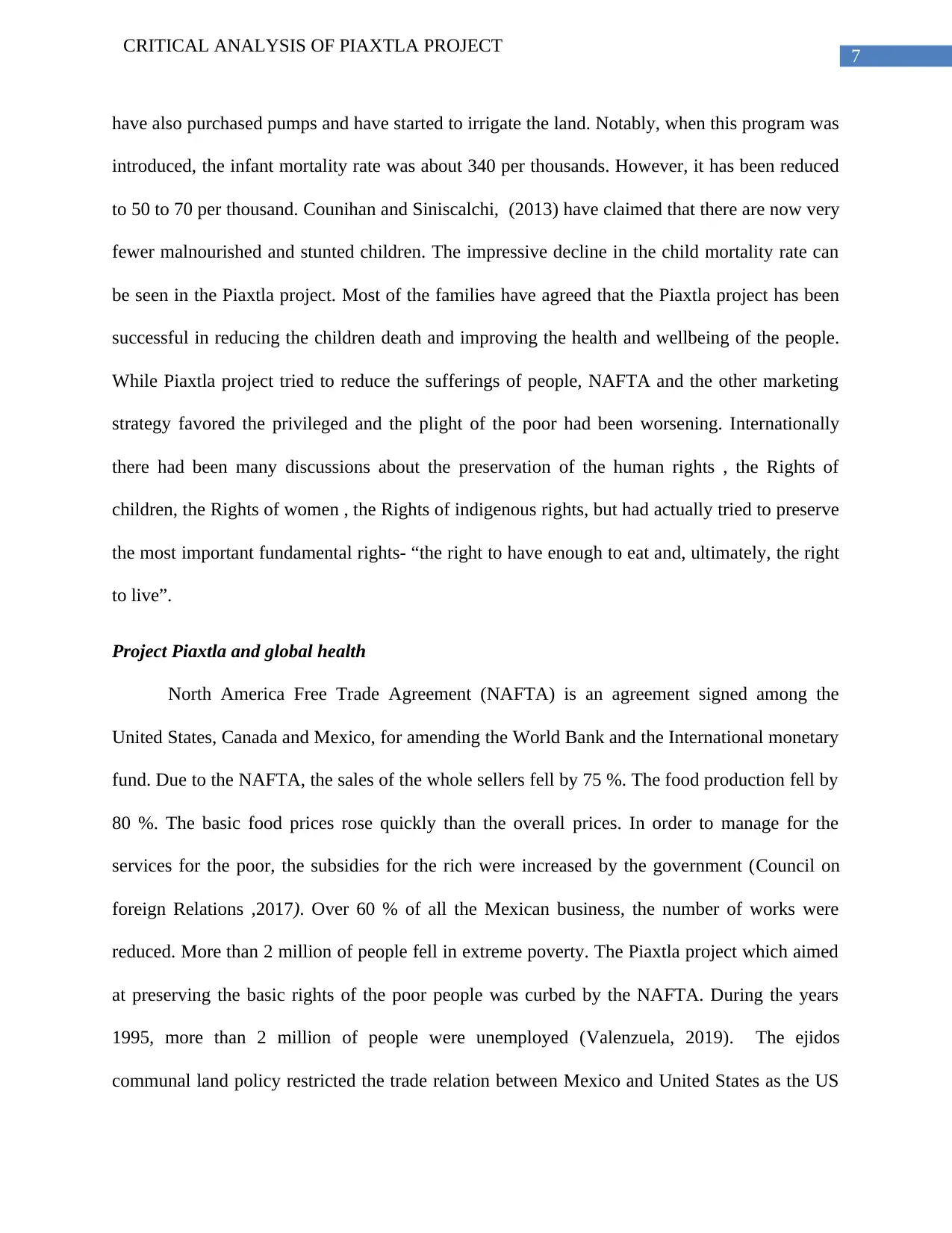
7
CRITICAL ANALYSIS OF PIAXTLA PROJECT
have also purchased pumps and have started to irrigate the land. Notably, when this program was
introduced, the infant mortality rate was about 340 per thousands. However, it has been reduced
to 50 to 70 per thousand. Counihan and Siniscalchi, (2013) have claimed that there are now very
fewer malnourished and stunted children. The impressive decline in the child mortality rate can
be seen in the Piaxtla project. Most of the families have agreed that the Piaxtla project has been
successful in reducing the children death and improving the health and wellbeing of the people.
While Piaxtla project tried to reduce the sufferings of people, NAFTA and the other marketing
strategy favored the privileged and the plight of the poor had been worsening. Internationally
there had been many discussions about the preservation of the human rights , the Rights of
children, the Rights of women , the Rights of indigenous rights, but had actually tried to preserve
the most important fundamental rights- “the right to have enough to eat and, ultimately, the right
to live”.
Project Piaxtla and global health
North America Free Trade Agreement (NAFTA) is an agreement signed among the
United States, Canada and Mexico, for amending the World Bank and the International monetary
fund. Due to the NAFTA, the sales of the whole sellers fell by 75 %. The food production fell by
80 %. The basic food prices rose quickly than the overall prices. In order to manage for the
services for the poor, the subsidies for the rich were increased by the government (Council on
foreign Relations ,2017). Over 60 % of all the Mexican business, the number of works were
reduced. More than 2 million of people fell in extreme poverty. The Piaxtla project which aimed
at preserving the basic rights of the poor people was curbed by the NAFTA. During the years
1995, more than 2 million of people were unemployed (Valenzuela, 2019). The ejidos
communal land policy restricted the trade relation between Mexico and United States as the US
CRITICAL ANALYSIS OF PIAXTLA PROJECT
have also purchased pumps and have started to irrigate the land. Notably, when this program was
introduced, the infant mortality rate was about 340 per thousands. However, it has been reduced
to 50 to 70 per thousand. Counihan and Siniscalchi, (2013) have claimed that there are now very
fewer malnourished and stunted children. The impressive decline in the child mortality rate can
be seen in the Piaxtla project. Most of the families have agreed that the Piaxtla project has been
successful in reducing the children death and improving the health and wellbeing of the people.
While Piaxtla project tried to reduce the sufferings of people, NAFTA and the other marketing
strategy favored the privileged and the plight of the poor had been worsening. Internationally
there had been many discussions about the preservation of the human rights , the Rights of
children, the Rights of women , the Rights of indigenous rights, but had actually tried to preserve
the most important fundamental rights- “the right to have enough to eat and, ultimately, the right
to live”.
Project Piaxtla and global health
North America Free Trade Agreement (NAFTA) is an agreement signed among the
United States, Canada and Mexico, for amending the World Bank and the International monetary
fund. Due to the NAFTA, the sales of the whole sellers fell by 75 %. The food production fell by
80 %. The basic food prices rose quickly than the overall prices. In order to manage for the
services for the poor, the subsidies for the rich were increased by the government (Council on
foreign Relations ,2017). Over 60 % of all the Mexican business, the number of works were
reduced. More than 2 million of people fell in extreme poverty. The Piaxtla project which aimed
at preserving the basic rights of the poor people was curbed by the NAFTA. During the years
1995, more than 2 million of people were unemployed (Valenzuela, 2019). The ejidos
communal land policy restricted the trade relation between Mexico and United States as the US
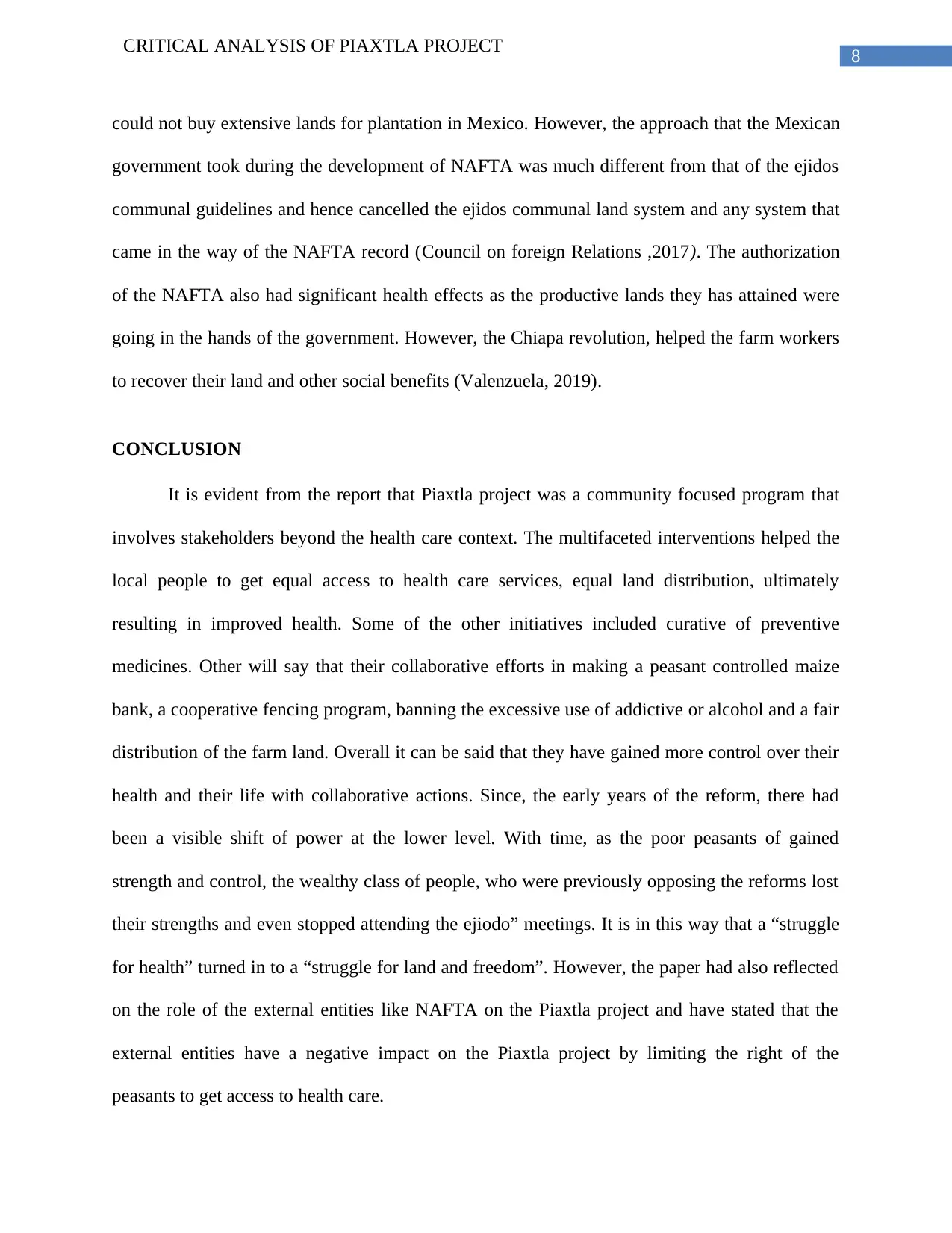
8
CRITICAL ANALYSIS OF PIAXTLA PROJECT
could not buy extensive lands for plantation in Mexico. However, the approach that the Mexican
government took during the development of NAFTA was much different from that of the ejidos
communal guidelines and hence cancelled the ejidos communal land system and any system that
came in the way of the NAFTA record (Council on foreign Relations ,2017). The authorization
of the NAFTA also had significant health effects as the productive lands they has attained were
going in the hands of the government. However, the Chiapa revolution, helped the farm workers
to recover their land and other social benefits (Valenzuela, 2019).
CONCLUSION
It is evident from the report that Piaxtla project was a community focused program that
involves stakeholders beyond the health care context. The multifaceted interventions helped the
local people to get equal access to health care services, equal land distribution, ultimately
resulting in improved health. Some of the other initiatives included curative of preventive
medicines. Other will say that their collaborative efforts in making a peasant controlled maize
bank, a cooperative fencing program, banning the excessive use of addictive or alcohol and a fair
distribution of the farm land. Overall it can be said that they have gained more control over their
health and their life with collaborative actions. Since, the early years of the reform, there had
been a visible shift of power at the lower level. With time, as the poor peasants of gained
strength and control, the wealthy class of people, who were previously opposing the reforms lost
their strengths and even stopped attending the ejiodo” meetings. It is in this way that a “struggle
for health” turned in to a “struggle for land and freedom”. However, the paper had also reflected
on the role of the external entities like NAFTA on the Piaxtla project and have stated that the
external entities have a negative impact on the Piaxtla project by limiting the right of the
peasants to get access to health care.
CRITICAL ANALYSIS OF PIAXTLA PROJECT
could not buy extensive lands for plantation in Mexico. However, the approach that the Mexican
government took during the development of NAFTA was much different from that of the ejidos
communal guidelines and hence cancelled the ejidos communal land system and any system that
came in the way of the NAFTA record (Council on foreign Relations ,2017). The authorization
of the NAFTA also had significant health effects as the productive lands they has attained were
going in the hands of the government. However, the Chiapa revolution, helped the farm workers
to recover their land and other social benefits (Valenzuela, 2019).
CONCLUSION
It is evident from the report that Piaxtla project was a community focused program that
involves stakeholders beyond the health care context. The multifaceted interventions helped the
local people to get equal access to health care services, equal land distribution, ultimately
resulting in improved health. Some of the other initiatives included curative of preventive
medicines. Other will say that their collaborative efforts in making a peasant controlled maize
bank, a cooperative fencing program, banning the excessive use of addictive or alcohol and a fair
distribution of the farm land. Overall it can be said that they have gained more control over their
health and their life with collaborative actions. Since, the early years of the reform, there had
been a visible shift of power at the lower level. With time, as the poor peasants of gained
strength and control, the wealthy class of people, who were previously opposing the reforms lost
their strengths and even stopped attending the ejiodo” meetings. It is in this way that a “struggle
for health” turned in to a “struggle for land and freedom”. However, the paper had also reflected
on the role of the external entities like NAFTA on the Piaxtla project and have stated that the
external entities have a negative impact on the Piaxtla project by limiting the right of the
peasants to get access to health care.
⊘ This is a preview!⊘
Do you want full access?
Subscribe today to unlock all pages.

Trusted by 1+ million students worldwide
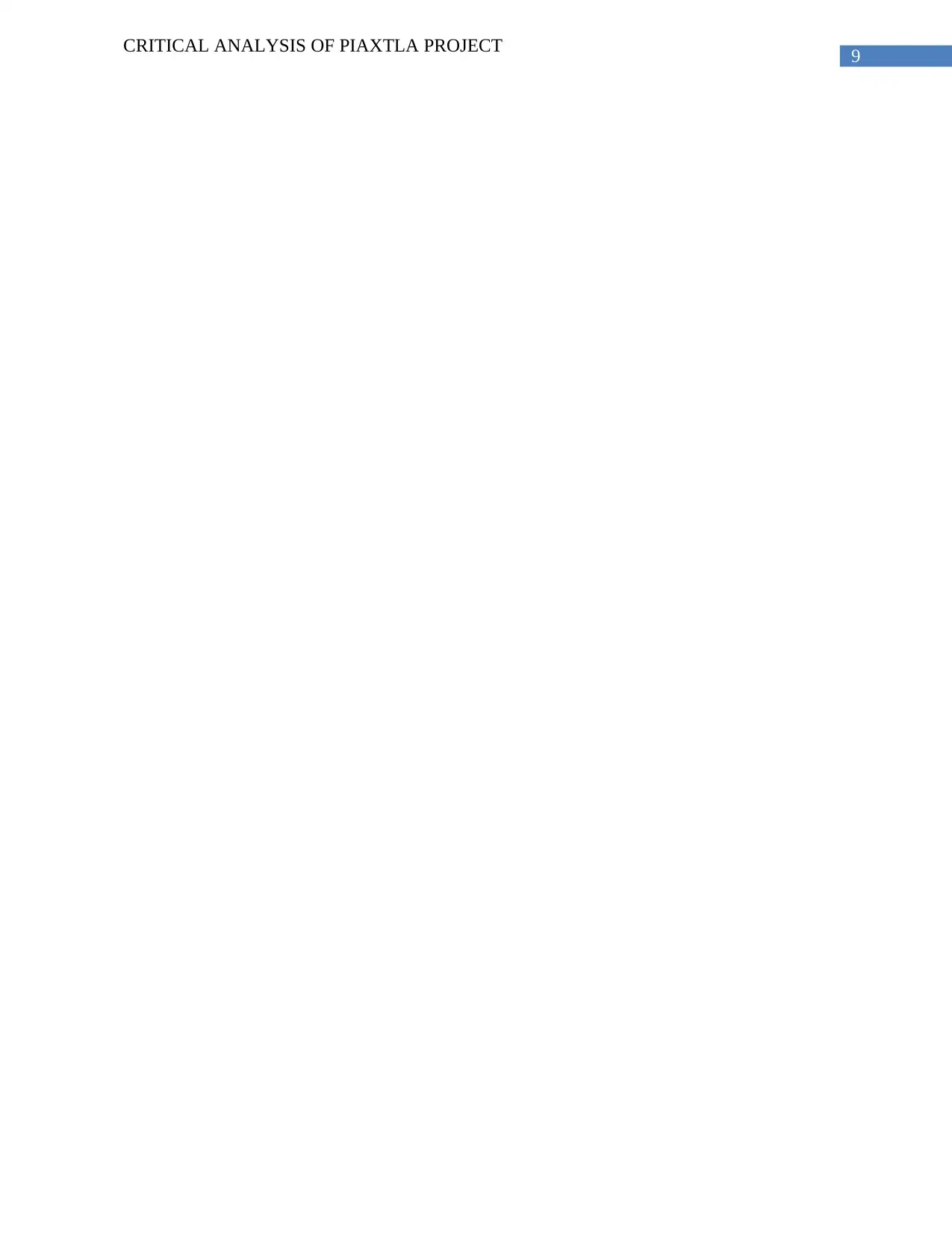
9
CRITICAL ANALYSIS OF PIAXTLA PROJECT
CRITICAL ANALYSIS OF PIAXTLA PROJECT
Paraphrase This Document
Need a fresh take? Get an instant paraphrase of this document with our AI Paraphraser
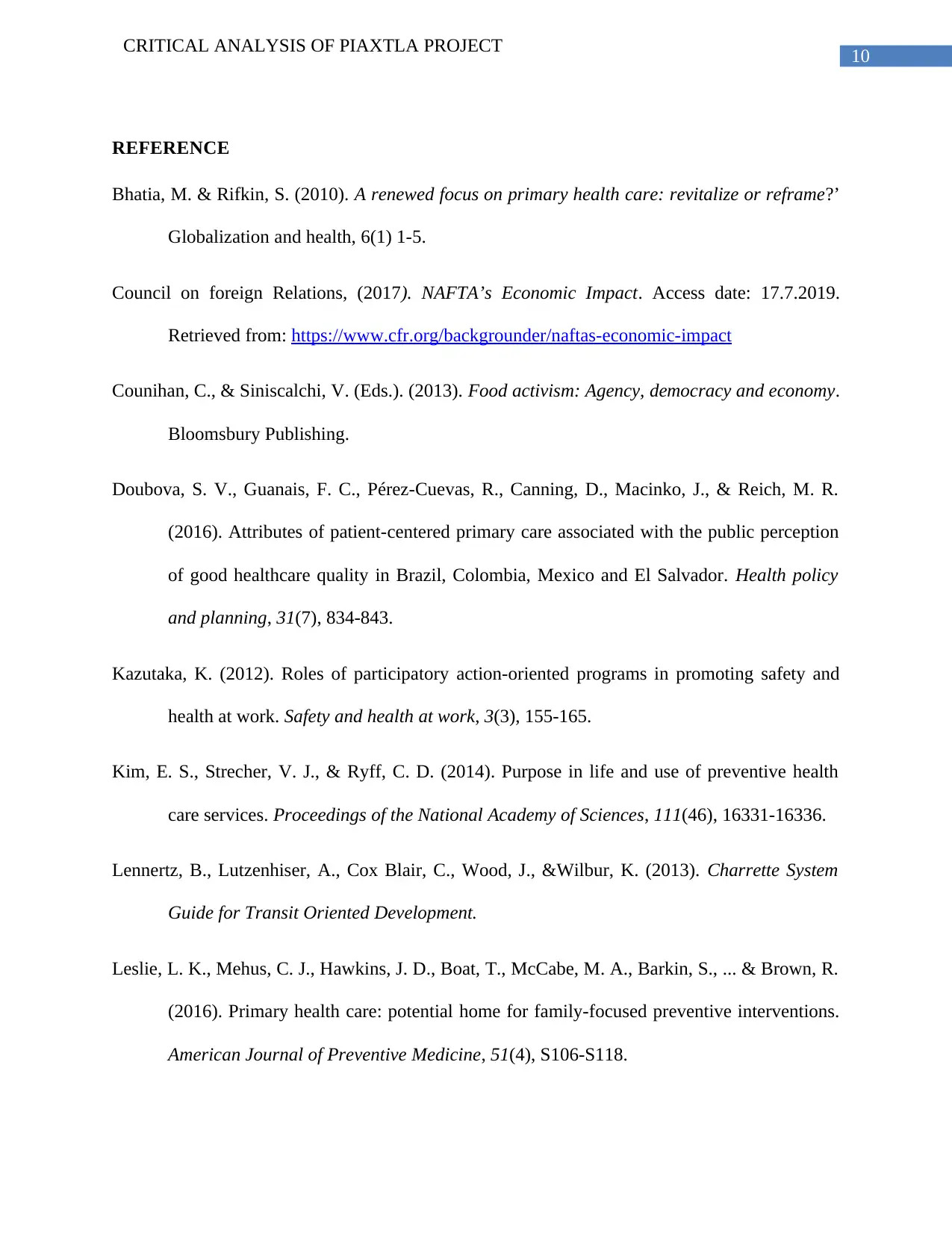
10
CRITICAL ANALYSIS OF PIAXTLA PROJECT
REFERENCE
Bhatia, M. & Rifkin, S. (2010). A renewed focus on primary health care: revitalize or reframe?’
Globalization and health, 6(1) 1-5.
Council on foreign Relations, (2017). NAFTA’s Economic Impact. Access date: 17.7.2019.
Retrieved from: https://www.cfr.org/backgrounder/naftas-economic-impact
Counihan, C., & Siniscalchi, V. (Eds.). (2013). Food activism: Agency, democracy and economy.
Bloomsbury Publishing.
Doubova, S. V., Guanais, F. C., Pérez-Cuevas, R., Canning, D., Macinko, J., & Reich, M. R.
(2016). Attributes of patient-centered primary care associated with the public perception
of good healthcare quality in Brazil, Colombia, Mexico and El Salvador. Health policy
and planning, 31(7), 834-843.
Kazutaka, K. (2012). Roles of participatory action-oriented programs in promoting safety and
health at work. Safety and health at work, 3(3), 155-165.
Kim, E. S., Strecher, V. J., & Ryff, C. D. (2014). Purpose in life and use of preventive health
care services. Proceedings of the National Academy of Sciences, 111(46), 16331-16336.
Lennertz, B., Lutzenhiser, A., Cox Blair, C., Wood, J., &Wilbur, K. (2013). Charrette System
Guide for Transit Oriented Development.
Leslie, L. K., Mehus, C. J., Hawkins, J. D., Boat, T., McCabe, M. A., Barkin, S., ... & Brown, R.
(2016). Primary health care: potential home for family-focused preventive interventions.
American Journal of Preventive Medicine, 51(4), S106-S118.
CRITICAL ANALYSIS OF PIAXTLA PROJECT
REFERENCE
Bhatia, M. & Rifkin, S. (2010). A renewed focus on primary health care: revitalize or reframe?’
Globalization and health, 6(1) 1-5.
Council on foreign Relations, (2017). NAFTA’s Economic Impact. Access date: 17.7.2019.
Retrieved from: https://www.cfr.org/backgrounder/naftas-economic-impact
Counihan, C., & Siniscalchi, V. (Eds.). (2013). Food activism: Agency, democracy and economy.
Bloomsbury Publishing.
Doubova, S. V., Guanais, F. C., Pérez-Cuevas, R., Canning, D., Macinko, J., & Reich, M. R.
(2016). Attributes of patient-centered primary care associated with the public perception
of good healthcare quality in Brazil, Colombia, Mexico and El Salvador. Health policy
and planning, 31(7), 834-843.
Kazutaka, K. (2012). Roles of participatory action-oriented programs in promoting safety and
health at work. Safety and health at work, 3(3), 155-165.
Kim, E. S., Strecher, V. J., & Ryff, C. D. (2014). Purpose in life and use of preventive health
care services. Proceedings of the National Academy of Sciences, 111(46), 16331-16336.
Lennertz, B., Lutzenhiser, A., Cox Blair, C., Wood, J., &Wilbur, K. (2013). Charrette System
Guide for Transit Oriented Development.
Leslie, L. K., Mehus, C. J., Hawkins, J. D., Boat, T., McCabe, M. A., Barkin, S., ... & Brown, R.
(2016). Primary health care: potential home for family-focused preventive interventions.
American Journal of Preventive Medicine, 51(4), S106-S118.
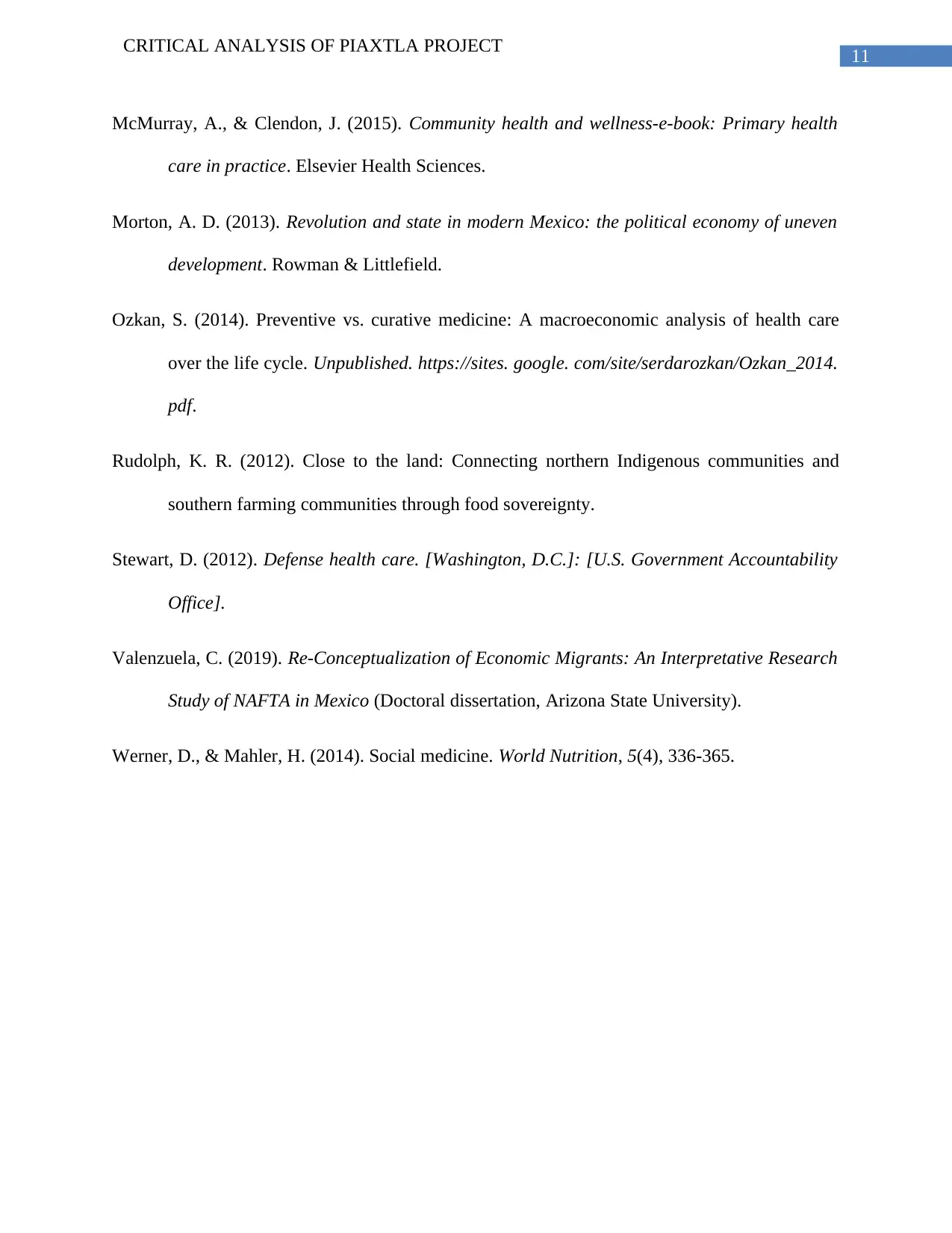
11
CRITICAL ANALYSIS OF PIAXTLA PROJECT
McMurray, A., & Clendon, J. (2015). Community health and wellness-e-book: Primary health
care in practice. Elsevier Health Sciences.
Morton, A. D. (2013). Revolution and state in modern Mexico: the political economy of uneven
development. Rowman & Littlefield.
Ozkan, S. (2014). Preventive vs. curative medicine: A macroeconomic analysis of health care
over the life cycle. Unpublished. https://sites. google. com/site/serdarozkan/Ozkan_2014.
pdf.
Rudolph, K. R. (2012). Close to the land: Connecting northern Indigenous communities and
southern farming communities through food sovereignty.
Stewart, D. (2012). Defense health care. [Washington, D.C.]: [U.S. Government Accountability
Office].
Valenzuela, C. (2019). Re-Conceptualization of Economic Migrants: An Interpretative Research
Study of NAFTA in Mexico (Doctoral dissertation, Arizona State University).
Werner, D., & Mahler, H. (2014). Social medicine. World Nutrition, 5(4), 336-365.
CRITICAL ANALYSIS OF PIAXTLA PROJECT
McMurray, A., & Clendon, J. (2015). Community health and wellness-e-book: Primary health
care in practice. Elsevier Health Sciences.
Morton, A. D. (2013). Revolution and state in modern Mexico: the political economy of uneven
development. Rowman & Littlefield.
Ozkan, S. (2014). Preventive vs. curative medicine: A macroeconomic analysis of health care
over the life cycle. Unpublished. https://sites. google. com/site/serdarozkan/Ozkan_2014.
pdf.
Rudolph, K. R. (2012). Close to the land: Connecting northern Indigenous communities and
southern farming communities through food sovereignty.
Stewart, D. (2012). Defense health care. [Washington, D.C.]: [U.S. Government Accountability
Office].
Valenzuela, C. (2019). Re-Conceptualization of Economic Migrants: An Interpretative Research
Study of NAFTA in Mexico (Doctoral dissertation, Arizona State University).
Werner, D., & Mahler, H. (2014). Social medicine. World Nutrition, 5(4), 336-365.
⊘ This is a preview!⊘
Do you want full access?
Subscribe today to unlock all pages.

Trusted by 1+ million students worldwide
1 out of 12
Related Documents
Your All-in-One AI-Powered Toolkit for Academic Success.
+13062052269
info@desklib.com
Available 24*7 on WhatsApp / Email
![[object Object]](/_next/static/media/star-bottom.7253800d.svg)
Unlock your academic potential
Copyright © 2020–2025 A2Z Services. All Rights Reserved. Developed and managed by ZUCOL.





